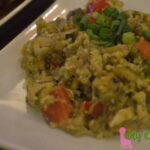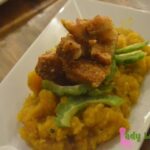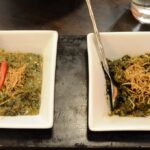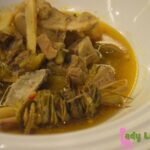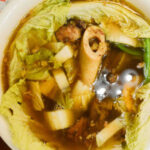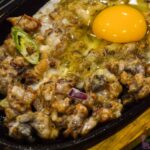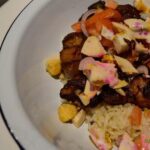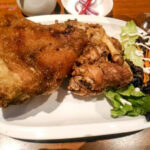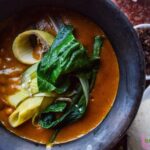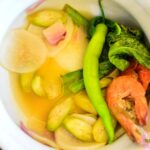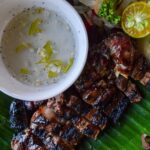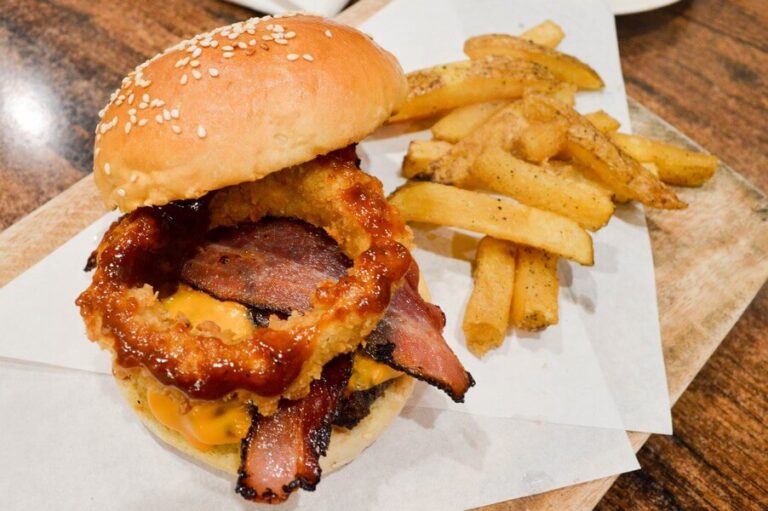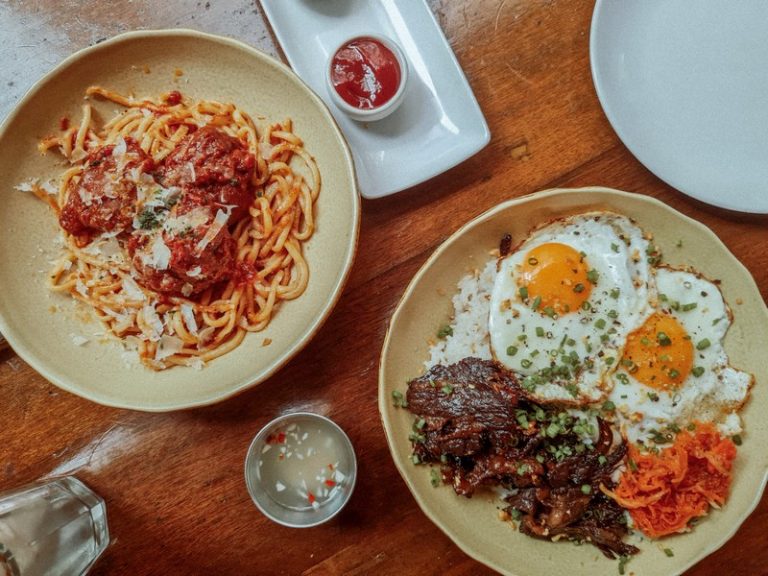Exploring the roots of Philippine cuisine offers valuable insight into the rich diversity of Filipino food. For first-time visitors to the Philippines, identifying the dominant cultural influences on Filipino cuisine may seem challenging.
If you ask a Filipino, they’ll likely say that Spanish and Chinese cuisines have had a significant impact on their food and that’s true. But what’s the full story?
The History of Filipino Cuisine
The history of Philippine cuisine can be traced back to its Austronesian origins, sharing similarities with Malaysian and Indonesian cuisines. Later, settlers from Southern China and Taiwan arrived in the Philippines around 3200 BCE, introducing new culinary practices.
During the British occupation of Manila, Indian influence emerged when Indian migrants who had accompanied British forces chose to stay in the Philippines.
Finally, the Spanish colonization (lasting over 300 years) and American occupation (for 48 years) further shaped Filipino cuisine. This is why tomato sauce frequently appears in local dishes, and why the Philippines has developed a strong love for fast food. This layered history has allowed Philippine cuisine to offer a wide variety of flavors to the world.
Culture of the Filipino Food
- Pulutan – Known as “finger food” in Western culture, pulutan is typically enjoyed with a cold beer. Popular options include chicharon, sisig, and roasted peanuts. Some Filipino restaurants also serve pulutan as appetizers. For a creative twist, Sentro 1771 enhances their chicharon with mushrooms for added flavor.
- Kamayan – Derived from the Filipino word “kamay” (meaning hands), kamayan refers to eating with your hands. This practice is common during outings or team-building events, inspired by the military tradition known as the “boodle fight.” While most Filipino restaurants provide utensils, you can still enjoy a kamayan experience at places like Seafood Island.
- Sutukil – A popular cooking method in the Visayan region, sutukil stands for:
- SUgba (grill)
- TUwa (stew)
- KILaw (seafood soaked in vinegar)
- Fiesta – While there’s no exact English translation for fiesta, it’s a cherished tradition adapted from Spanish culture. Unlike Thanksgiving, which is celebrated nationwide on the same day, fiestas take place on specific dates linked to a town’s patron saint. During fiestas, families prepare large amounts of food, and visitors even strangers are warmly welcomed to dine in any home. While this tradition thrives in the provinces, it’s less common in Metro Manila.
- Provincial Specialties – During fiestas or visits to provincial areas, don’t miss out on their unique ulam (dishes served with rice). Each province offers distinct culinary specialties that are well worth trying.
- Poqui-poqui
- Dinuydoy
- Laing
- Kansi
- Bulalo
- Sisig
On the gallery:
- Poqui-poqui, dinuydoy, and beef kansi of Grilla restaurant
- Laing of Mesa restaurant
- Bulalo of Uncle Cheffy’s Tagaytay restuarant
- Sisig of Bagneto
Philippines Food List
After exploring the specialty dishes of various provinces, here’s a list of common Filipino foods enjoyed in everyday life.
Agahan or Breakfast
- Silog – Any dish with the suffix “-silog” is composed of fried rice and egg. Popular varieties include:
- Hotsilog – with hotdog
- Bacsilog – with bacon
- Longsilog – with longganisa (Filipino sausage)
- Tapsilog – with tapa (thin slices of cured beef, best served with vinegar on the side)
- Among these, tapsilog is the most recommended for its rich, savory flavor.
- Champorado and Tuyo – This breakfast combo pairs chocolate porridge with salted dried fish, creating a delightful blend of sweet and salty flavors.
- Pandesal and Kesong Puti – Pandesal is a classic Filipino bread roll often stuffed with kesong puti, a soft cheese made from carabao’s milk.
- Arroz Caldo – A comforting Filipino rice porridge, typically chicken-flavored, seasoned with ginger, and garnished with toasted garlic, scallions, and black pepper.
Ulam or Everyday Food
Appetizer
- Lumpiang ubod – A Filipino appetizer made with ubod (heart of palm), combined with various meats and vegetables, all wrapped in a thin egg crêpe.
Main Dish
- Adobo – A popular dish made with pork slices cooked in soy sauce, vinegar, and garlic, resulting in a savory and tangy flavor
- Crispy pata – A whole pork leg that’s boiled with seasonings, then deep-fried until golden and crispy.
- Kare Kare – A rich and thick peanut stew often served with vegetables and meat. While this was traditionally considered the Filipino version of curry, Filipinos also enjoy authentic curry dishes as part of their regular meals.
- Sinigang – A sour soup typically made with pork, though fish or shrimp can also be used as the main protein.
- Dinuguan at puto – Dinuguan is a savory stew made from pig’s blood, mixed with bite-sized pork, and flavored with vinegar, garlic, onions, and chili peppers. It’s commonly paired with puto, soft and fluffy steamed rice cakes.
- Kinilaw – A raw seafood dish similar to ceviche, marinated in vinegar, calamansi, and various seasonings.
- Inihaw na Liempo – Also known as Grilled Pork Belly, this dish is a Filipino favorite often served with a dipping sauce made of soy sauce, vinegar, and chili.
- Adobo
- Crispy Pata
- Kare-kare
- Sinigang
- Dinuguan at Puto
- Liempo
On the gallery:
- Adobo of Commune, Makati
- Crispy Pata of After All, Makati
- Kare-kare and liempo of Cloud 9 Restaurant, Antipolo
- Sinigang of Dekada, Makati
- Dinuguan at Puto of Guevarra’s Restaurant, San Juan
Noodles
- Pancit Palabok – A Filipino noodle dish flavored with shrimp gravy. It’s typically topped with shrimp, smoked fish flakes, pork cracklings, and eggs, creating a rich and savory flavor.
Vegetables
- Pinakbet – A traditional vegetable dish made of mixed vegetables steamed in fish sauce or shrimp paste. This dish is often enriched with pork for added flavor.
Merienda or Snacks
- Bibingka – A classic baked rice cake made from milled rice and traditionally cooked in clay pots lined with banana leaves for a distinct aroma.
- Suman – A Filipino rice cake made from glutinous rice cooked in coconut milk. It’s commonly wrapped in banana leaves, coconut leaves, or buri palm leaves for steaming.
- Biko – A sweet rice cake made with glutinous rice, coconut milk, and brown sugar, usually topped with latik (caramelized coconut curds) for added sweetness.
Minatamis or Desserts
- Halohalo – A popular Filipino dessert made with shaved ice, layered with ingredients like sweet beans, gelatin, sugar palm, banana, and jackfruit. It’s topped with leche flan and ube or vanilla ice cream, then drizzled with evaporated milk for a creamy finish.
Restaurants in the Philippines
If you’re wondering whether the Philippines offers other exciting cuisines, rest assured that the country’s food industry continues to thrive. In 2018, the number of registered food establishments increased to 86,812, showing the industry’s rapid growth. Filipino restaurants constantly introduce new dishes to attract both locals and tourists.
If you want to visit a restaurant with specific cuisine, here are some of the list to check out.
- American restaurant
- Australian restaurant
- Canadian restaurant
- Chinese restaurant
- Filipino-fusion restaurant
- Filipino restaurant
- Italian restaurant
- Japanese restaurant
- Korean restaurant
- Spanish restaurant
- Tex-mex restaurant
(Due to coronavirus pandemic, some restaurants that are reviewed may have changed its operational hours or has closed due to economic crisis. Disclaimer: This post is for informational purposes only.)
If you don’t have any specific cuisine in mind, you may check out a few of the restaurant reviews below by checking out the cities of Metro Manila.

